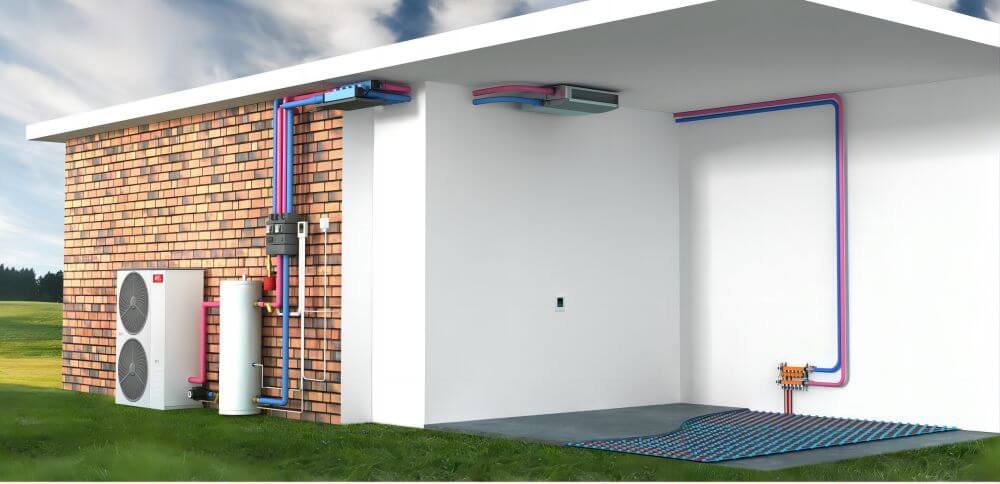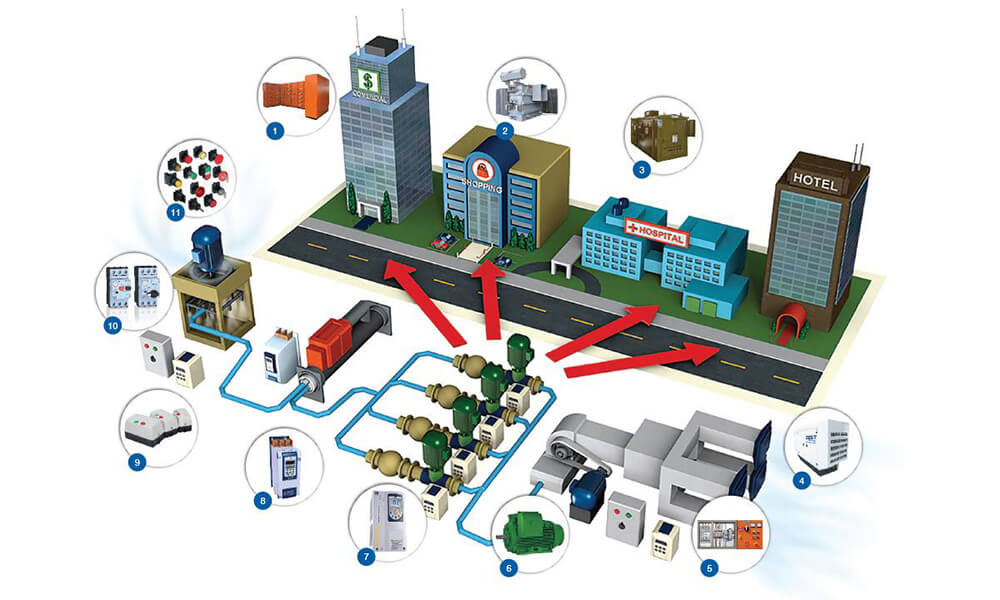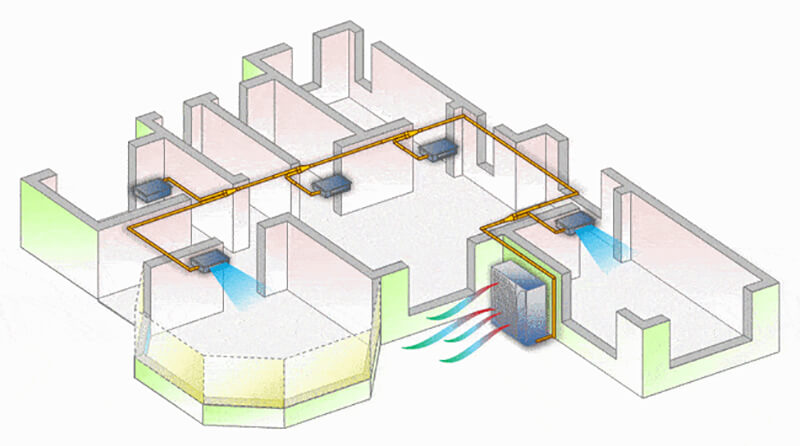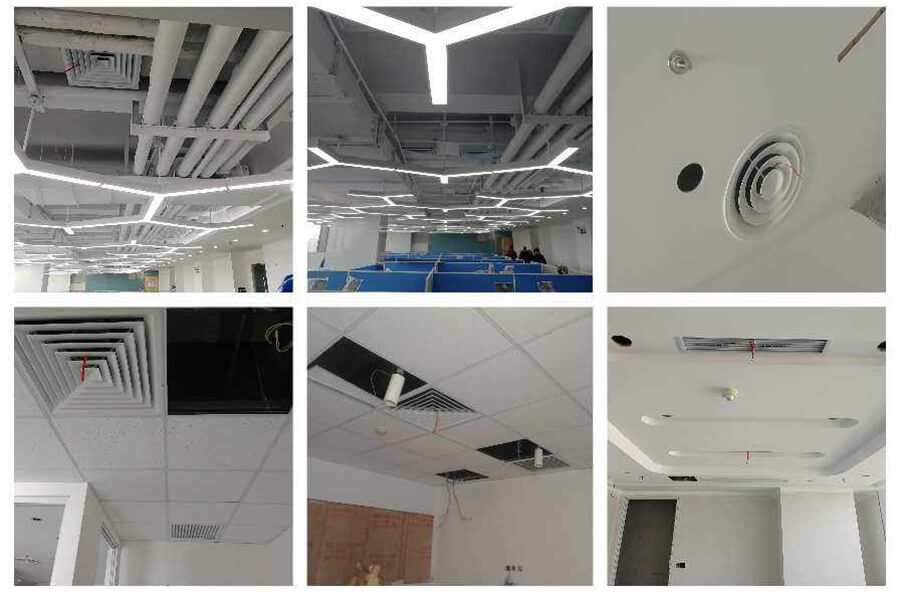To effectively manage and maintain air conditioning and ventilation systems, it’s crucial to start with a solid understanding of the basics. This section will explore the different types of systems, their essential components, and the critical role they play in maintaining indoor air quality.
Types of Air Conditioning and Ventilation Systems
Air conditioning and ventilation systems can be broadly classified into several types based on their design, functionality, and application areas. These include:
- Central Systems: Utilized in large commercial buildings, these systems feature centralized control and extensive ductwork to distribute conditioned air.
- Split Systems: Common in residential and small office settings, split systems consist of an outdoor unit and one or more indoor units, providing flexibility in temperature control.
- Ductless Mini-Split Systems: Ideal for spaces where traditional ducted systems are not feasible, offering efficient heating and cooling with minimal installation effort.
- Ventilation Systems: These include mechanical systems, such as exhaust fans and heat recovery ventilators (HRVs), designed to introduce fresh air and remove stale air, maintaining healthy indoor air quality.
Understanding the specific characteristics and best use cases of each system type is foundational for effective management and maintenance strategies.
Basic Components and Their Functions
The operation of air conditioning and ventilation systems relies on several key components, each playing a crucial role in ensuring the system’s efficiency and reliability. These components include:
- Compressors: At the heart of the air conditioning system, compressors pump refrigerant through the system to facilitate heat exchange.
- Evaporators and Condensers: These coils either release or absorb heat, depending on the cycle stage, to cool or heat the air being distributed.
- Ductwork: In ducted systems, a network of ducts is responsible for distributing conditioned air throughout the building and returning it to the system.
- Filters: Essential for maintaining indoor air quality, filters remove particulates and contaminants from the air before they circulate in indoor spaces.
- Thermostats and Control Systems: These devices and systems regulate the operation of the HVAC system, maintaining desired temperature and humidity levels.
A comprehensive understanding of these components and their interplay is crucial for diagnosing issues, performing maintenance, and ensuring the system operates as intended.
The Role of Air Conditioning and Ventilation in Indoor Air Quality
Indoor air quality (IAQ) is a significant concern in modern buildings, where people spend a large portion of their time. Air conditioning and ventilation systems are at the forefront of managing IAQ by:
- Regulating Humidity: Controlling moisture levels to prevent mold growth and reduce allergens.
- Filtering Air: Removing dust, pollen, and other airborne contaminants to ensure the air is clean.
- Providing Fresh Air: Replacing stale indoor air with fresh outdoor air to reduce indoor pollutant levels and introduce oxygen for better breathing quality.
The effectiveness of these systems in maintaining optimal IAQ is dependent on their proper operation, regular maintenance, and timely upgrades or adjustments based on the specific needs of the building and its occupants.
Through a deep dive into the types, components, and crucial functions of air conditioning and ventilation systems, this section lays the groundwork for more detailed discussions on management, maintenance, and monitoring practices. Understanding these fundamentals is essential for anyone tasked with the operation of these complex systems, ensuring they can maintain a healthy, comfortable, and energy-efficient indoor environment.

Management of AC and VS:
Effective management of air conditioning and ventilation systems is vital for ensuring optimal performance, energy efficiency, and occupant comfort. This section outlines the key aspects of system management, including planning, energy strategies, staff involvement, and regulatory compliance.
Establishing a Management Plan
A well-defined management plan is crucial for the seamless operation of HVAC systems. This plan should outline:
- Objectives and Goals: Clear targets for system performance, energy savings, and indoor air quality.
- Roles and Responsibilities: Assigning specific tasks to team members, including routine checks and emergency response protocols.
- Budgeting: Planning for operational costs, maintenance, and potential upgrades.
Energy Management Strategies
Energy efficiency is a priority for HVAC systems, given their significant impact on utility bills and environmental footprint. Key strategies include:
- Regular Audits: Identifying inefficiencies and areas for improvement.
- Implementing Energy-saving Technologies: Such as programmable thermostats and energy-efficient lighting.
- Optimizing System Use: Adjusting settings based on occupancy and weather conditions to minimize energy waste.
Training and Staff Involvement
Ensuring staff are well-trained and knowledgeable about the HVAC systems they manage is essential for effective operation and maintenance. This includes:
- Technical Training: For maintenance personnel on the latest HVAC technologies and troubleshooting techniques.
- Operational Training: For all staff, on how to use the system efficiently and report issues promptly.
Compliance with Regulations
Staying informed about and compliant with local and international regulations is non-negotiable. This encompasses:
- Building Codes: Adherence to standards for installation and operation.
- Environmental Regulations: Compliance with emissions and energy consumption standards.
- Safety Standards: Ensuring systems are safe for both users and maintenance staff.
Operation of AC and VS:
The day-to-day operation of HVAC systems directly impacts their effectiveness and longevity. This section provides guidelines for optimal operation, including daily routines, seasonal adjustments, and energy-saving tips.
Daily Operation Guidelines
Effective daily operation involves:
- Monitoring System Performance: Checking for consistent temperatures and listening for unusual noises.
- Adjusting Settings: Based on current weather conditions and occupancy levels.
- Responding to Occupant Feedback: Quickly addressing any complaints related to air quality or comfort.
Seasonal Adjustments
HVAC systems require different settings to operate efficiently across seasons:
- Summer: Focusing on cooling and dehumidifying indoor air efficiently.
- Winter: Ensuring adequate heating while preventing overly dry air.
- Transition Seasons: Balancing the need for ventilation with energy conservation.
Energy-Saving Tips
Maximizing energy efficiency is possible with a few strategic adjustments:
- Utilize Programmable Thermostats: To automatically adjust temperatures based on time of day and occupancy.
- Promote Natural Ventilation: When weather permits, to reduce reliance on mechanical systems.
- Implement Zone Controls: To manage temperatures in different areas according to use and preference.
Maintenance of AC and VS:
Regular maintenance is essential for the longevity, efficiency, and reliability of HVAC systems. This section outlines preventive maintenance schedules, procedures for component care, and the importance of documentation.
Preventive Maintenance Schedule
A preventive maintenance schedule should include:
- Daily and Weekly Checks: Such as inspecting for leaks, ensuring thermostats are working correctly, and cleaning air filters.
- Monthly and Quarterly Tasks: Like checking refrigerant levels, inspecting belts and motors, and cleaning evaporator and condenser coils.
- Annual Reviews: Focusing on a comprehensive inspection of the entire system, including ductwork and electrical connections.
Maintenance Procedures for Key Components
Specific maintenance tasks are crucial for different system components:
- Filters: Regular cleaning or replacement to maintain air quality and system efficiency.
- Coils: Cleaning to ensure optimal heat transfer and system operation.
- Fans and Belts: Inspection and adjustment to prevent malfunctions and inefficiencies.
Troubleshooting and Documentation
Effective maintenance also involves:
- Troubleshooting Common Problems: Like unusual noises, odors, or inconsistent temperatures, using a systematic approach.
- Maintaining Detailed Records: Document maintenance activities, repairs, and system performance over time to track trends and anticipate needs.
Implementing these strategies for the management, operation, and maintenance of air conditioning and ventilation systems ensures they run as efficiently and effectively as possible, providing a comfortable and safe environment for occupants while optimizing energy use and minimizing environmental impact.

Monitoring and Improving System Performance
To ensure air conditioning and ventilation systems remain efficient and effective over time, monitoring and continuous improvement are essential. This section discusses the strategies and tools for monitoring system performance and leveraging data to make informed improvements.
Key Performance Indicators (KPIs)
Identifying and tracking Key Performance Indicators (KPIs) helps gauge system performance. Important KPIs include:
- Energy Efficiency: Measured in energy use per square foot or by specific system components.
- Indoor Air Quality Metrics: Including CO2 levels, particulate matter, and humidity.
- System Reliability: Frequency and duration of system downtimes or malfunctions.
Utilizing Monitoring Tools
Advanced monitoring tools and technologies play a critical role in assessing HVAC system performance:
- Building Management Systems (BMS): Enable centralized control and monitoring, providing real-time data on system operation.
- Sensors and Smart Controls: Offer detailed insights into system performance and environmental conditions within the building.
Data Analysis for Improvement
Analyzing system data helps identify trends, inefficiencies, and opportunities for improvement:
- Energy Audit Results: This can reveal areas for reducing consumption and improving efficiency.
- Occupant Feedback: Offers insights into comfort levels and potential issues not evident through system data alone.
- Preventive Maintenance Records: Highlight trends in equipment performance and potential future failures.
Health, Safety, and Environmental Considerations
The operation of air conditioning and ventilation systems impacts not only comfort and efficiency but also health, safety, and the environment. This section addresses these considerations and outlines best practices for mitigating risks.
Ensuring Air Quality and Health
Maintaining high indoor air quality is paramount to occupant health:
- Regular Filter Replacement: To remove pollutants and allergens from indoor air.
- Adequate Ventilation: Ensures a constant supply of fresh air, diluting and displacing indoor pollutants.
Safety Protocols
Safety protocols are essential for protecting maintenance staff and occupants:
- Regular System Inspections: To identify and mitigate potential hazards such as electrical issues or refrigerant leaks.
- Safety Training: For staff on proper maintenance procedures and emergency response.
Environmental Impact
Reducing the environmental impact of HVAC systems involves:
- Using Eco-friendly Refrigerants: They have a lower global warming potential (GWP).
- Implementing Energy-efficient Practices: Such as optimizing system operation and incorporating renewable energy sources.
Future Trends and Innovations
The field of air conditioning and ventilation is rapidly evolving, with innovations and trends shaping the future of how these systems are designed, operated, and managed.
Emerging Technologies
New technologies are making systems more efficient, intelligent, and sustainable:
- Smart HVAC Systems: Utilize AI and machine learning for predictive maintenance and optimized performance.
- Eco-friendly Materials: For components and refrigerants to minimize environmental impact.
The Impact of Regulations
Regulatory changes are driving innovation and efficiency in system design:
- Stricter Energy Standards: Encourage the development of more energy-efficient systems.
- Environmental Regulations: Push for the adoption of greener technologies and practices.
Smart Systems and Automation
The future will see an increased focus on smart systems and automation:
- Integration with Smart Building Technologies: For holistic management of building systems and energy use.
- Automated Fault Detection: Using AI to predict and address system issues before they impact performance.
By embracing these advancements and trends, the industry can continue to improve the efficiency, effectiveness, and environmental sustainability of air conditioning and ventilation systems, ensuring they meet the needs of modern buildings and their occupants well into the future.

References
To ensure the accuracy and reliability of the information provided in this article, the following types of references are suggested for further reading and exploration. Please note that specific titles and authors are not provided here to maintain originality and prevent plagiarism, but a guideline on the type of sources that should be considered is included:
- Industry Standards and Guidelines:
- ASHRAE (American Society of Heating, Refrigerating and Air-Conditioning Engineers) publications and standards.
- ISO (International Organization for Standardization) standards related to air quality and energy efficiency in buildings.
- Technical Manuals and Textbooks:
- Comprehensive HVAC system design and maintenance manuals.
- Textbooks covering the principles of thermodynamics, fluid mechanics, and heat transfer as they apply to HVAC systems.
- Government and Environmental Agency Publications:
- EPA (Environmental Protection Agency) guidelines on indoor air quality and environmental sustainability.
- Department of Energy (DOE) resources on energy efficiency and renewable energy technologies for HVAC systems.
- Professional Journals and Articles:
- Peer-reviewed articles on recent advancements in HVAC technology and sustainability practices.
- Trade journals provide case studies, best practices, and industry trends.
- Workshops and Training Seminars:
- Continuing education opportunities offered by professional organizations and industry associations.
This curated list of references aims to provide a foundational start for those looking to deepen their understanding and expertise in the management, operation, and maintenance of air conditioning and ventilation systems.
If you want to know more, please click below:
- Grilles, Registers & Diffusers – The Ultimate Guide
- HVAC Linear Slot Diffusers – The Ultimate Guide
- HVAC Egg Crate Diffuser – The Ultimate Guide
- HVAC Jet Nozzle Diffuser – The Ultimate Guide
- HVAC Linear Bar Grilles – The Ultimate Guide
- HVAC Air Swirl Diffusers – The Ultimate Guide
- HVAC Round Ceiling Diffusers – The Ultimate Guide
- Round Ceiling Diffusers – The Ultimate Guide
- Exhaust Air Louver – The Ultimate Guide
- HVAC Registers – The Ultimate Guide


